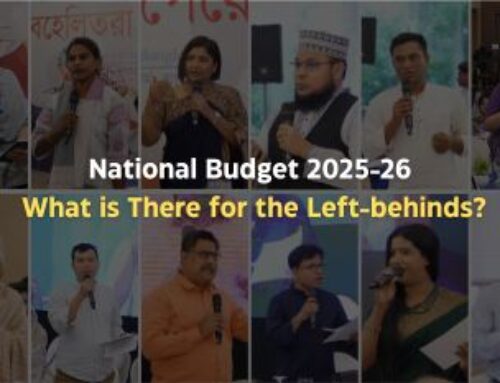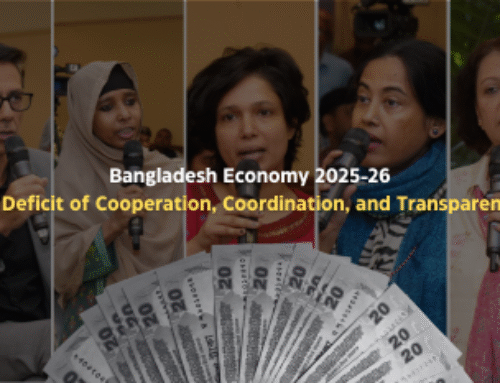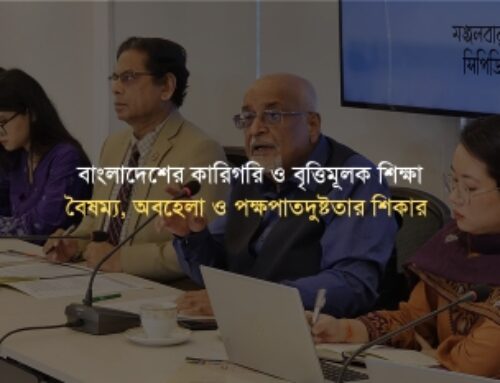The second wave has not been considered in preparation of the budgetary numbers and thus, in general, all projections for FY2021-22 are on the higher side. Relevant budgetary figures show that FY2020-21 was a better than FY2019-20 – which is not supported by other evidence. Expansionary fiscal stance – Emphasis on generating investible surplus (tax/tariff rebates), less on household level disposable income (direct fiscal transfers). No measures to scale up impactful public expenditure (ADP). More for organised (large) business sector, much less for middle class, MSME & LNOB and PNOB. No consequential and structured pandemic mitigating and post-pandemic recovery programme.
These observations emerged at the virtual media briefing titled “National Budget 2021-22: What is there for the “disadvantaged people” held on 06 June 2021.

Dr Debapriya Bhattacharya, Convenor, Citizen’s Platform for SDGs, Bangladesh and Distinguished Fellow, Centre for Policy Dialogue (CPD), made the keynote presentation at the media briefing. In the 2030 Agenda for Sustainable Development, there were 12 SDGs along with 21 indicators that had a 2020 deadline. However, while the SDGs have been mentioned, their performance indicators have not been mentioned in the National Budget (2021-22). Out of the 12 SDGs, only 2 of the targets (17%) have been officially recognized to be on track in the SDR 2020 while 6 of the SDGs are in the red (50%) and facing major challenges. Two of the SDGs (17%) are in the orange facing significant challenges, while the last two SDGs (17%) face some challenges, they are in the yellow. The weakest areas in terms of meeting SDG targets in 2020 has centred around citizen well-being, clean water sources, internet and information access and availability of timely, reliable and disaggregated data.
Health Services Division could not spend 75% of the allocation of ADP in 10 months of FY2020-21. Medical Education and Family Welfare Division could not spend 50% of the allocation. Several projects are yet to be implemented fully (including boosting oxygen supply to ICUs and health facilities at the grassroots).
Fiscal incentives not sufficiently linked to employment generation, particularly for the traditionally left behind groups as well as the “new poor” due to the pandemic. Leaving out the informal sector will disproportionately burden women. No concrete measure targeting the employment of “disengaged youth”, and female youth in the formal sector.
The philosophy of the budget is to reduce the inequality of income, consumption and wealth between the poor and the rich. But measures for bringing down inequality is not visible. The government should have widened the allocation for social safety net programmes, stated by Professor Mustafizur Rahman, Distinguished Fellow, CPD and Core Group Member, Citizen’s Platform for SDGs, Bangladesh.
Platform’s Core Group Member and Convenor, Bangladesh Health Watch, Dr Mushtaque Raza Chowdhury, praised tax exemption of the health sector in this year’s budget. But the question is, who are the benefitted group here?
Education was seen most neglected in National Budget 2021-2022 allocation, said Rasheda K Choudhury, Executive Director, Campaign for Popular Education (CAMPE). She added, “I don’t see any budget for educational research. There was already inequality in the education system. But this inequality is more evident, especially for the disadvantaged people, who cannot buy a digital device.”
Advocate Sultana Kamal, Core Group Member, Citizen’s Platform for SDGs, Bangladesh Chaired the virtual media briefing and said, our focus of the discussion was to concentrate on the implementation of this year’s budget in connection to achieving SDGs.
The event began with introductory remarks by Anisatul Fatema Yousuf, Coordinator, Citizen’s Platform for SDGs, Bangladesh. Shaheen Anam, Executive Director, Manusher Jonno Foundation and Asif Ibrahim, Vice Chairman, New Age Group of Industries and Chairman, Chittagong Stock Exchange (CSE), were also present at the event and shared their views through responding to questions from the media.





